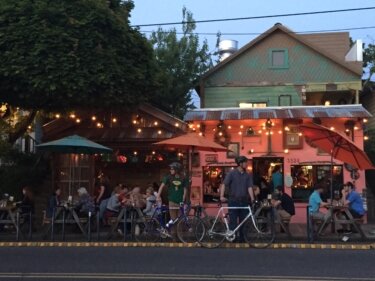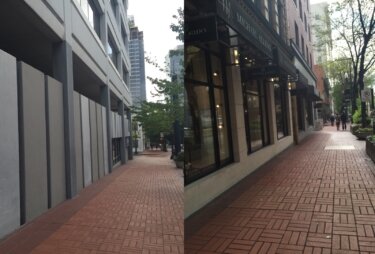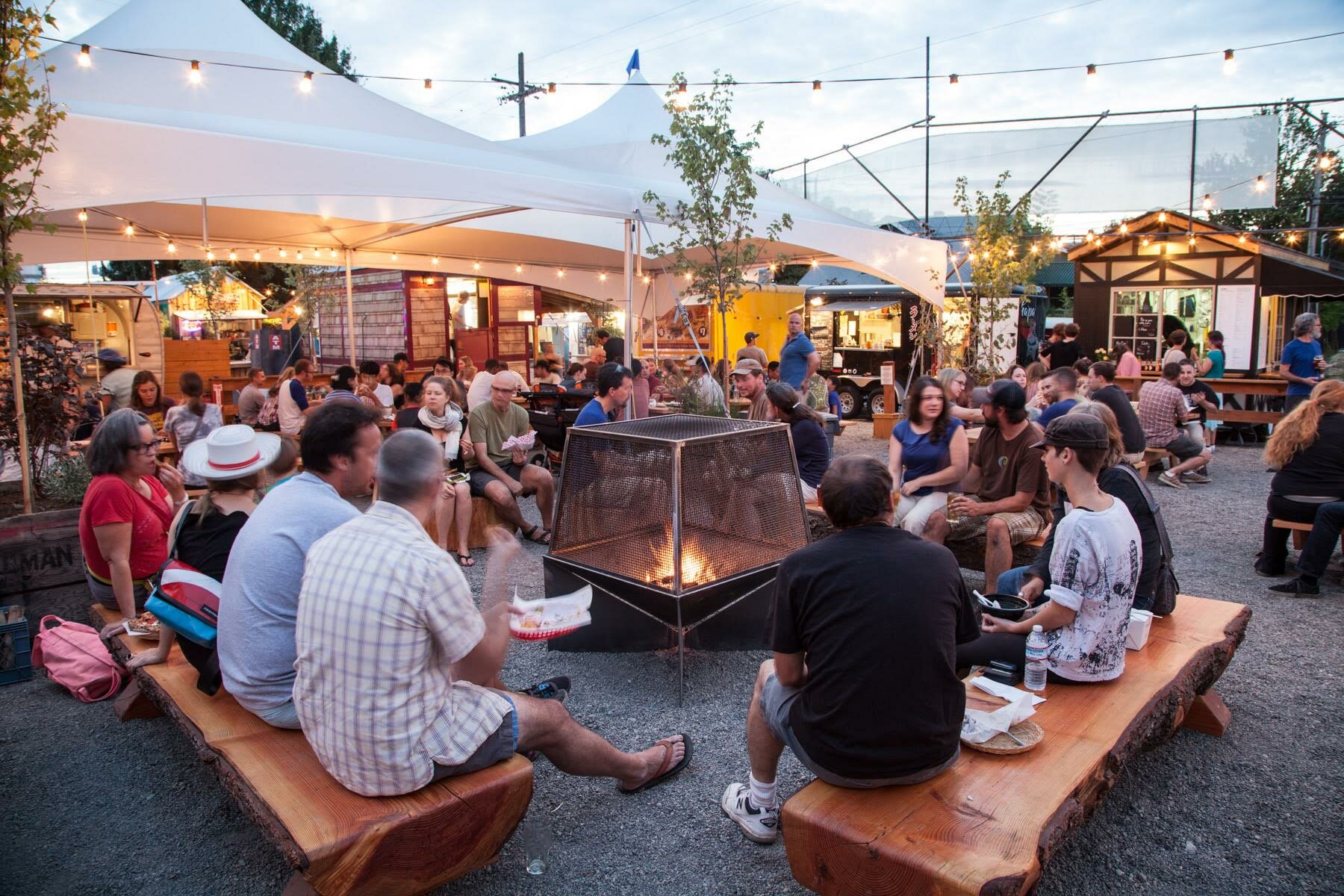"The more successfully a city mingles everyday diversity of uses and users in its everyday streets, the more successfully, casually (and economically) its people thereby enliven and support well-located parks that can thus give back grace and delight to their neighbourhoods instead of vacuity."
The Doable City Reader
There is so much that can be done to make our cities happier, healthier and more prosperous places. Every day in cities around the world, citizens and city planners alike are showing us how small actions can scale up to have massive impact. And they can in your city too.
That’s what the Doable City Reader is about. In June 2014, 8 80 Cities, in collaboration with the Knight Foundation, brought 200 civic innovators from around North America together in Chicago at the Doable City Forum to share and discover methods for rapid change-making. The Doable City Reader is inspired by the rich conversations amongst presenters and participants at that forum. It is a resource for any and all people who want to make change in their cities and is meant to educate, inspire and empower anyone to do so.
In biological terms, a community is classified as a group of organisms living in a shared space. An ecosystem, on the other hand, is made up of both living and nonliving components. In a forest ecosystem, plants, insects and animals are the communities, while sunlight, soil and nutrients are the equally important non-living components.
In the context of a city, we tend to define communities geographically. But what if we considered our neighbourhoods and streets ecosystems? In urban settings, humans and businesses act as communities while roads and sidewalks are its non-living components.
The health of a community, in the forest or city, relies on constant interaction with both the living and non-living aspects of the ecosystem. A lively business community attracts customers, but the same business community supported by quality public space that is filled with people attracts more customers. Conversely, a good public space accompanied by a vibrant business community becomes more active and engaging. The two operate in symbiosis.
In his book Life Between Buildings, Danish architect Jan Gehl outlines how the quality of outdoor public space influences how often and for what purposes a space is used. Gehl, who has observed behaviour in public spaces around the world, notes that when the quality of a public space is low, it is used only for necessary tasks like walking the dog or getting to the bus stop.
When a space is welcoming, designed to be accessible and enjoyable, “a wide range of optional activities” will occur in between those necessary tasks, writes Gehl. These might include spontaneous social interaction, reading a book, eating, window shopping or simply being in and enjoying the space. A good public realm brings people out of their homes and offices and into the world. And that’s good for business.
The economic benefit of good public space
Like any ecosystem, the city ecosystem is cyclical; it is difficult if not impossible to pin down exactly where it begins and ends. A strong business community means jobs, which help people save and invest in property. They pay property taxes, which go toward parks, trees and improving infrastructure to support commercial zones. All of this results in a higher quality of living for urban residents, and that means residents are more likely to stay in their communities and support a strong local business economy.
Let’s start with green space. There’s value in massive urban parks like New York City’s Central Park, but green space also includes the tiniest patch of grass between a sidewalk and roadway, and street trees that encourage pedestrian traffic. In fact, business owners have reported up to a 12 per cent increase in revenue where trees have been planted, according to walkability expert Dan Burden.
In Portland, Ore., an estimated 26 per cent of the city is under the canopy of trees. In 2010 it was estimated that street trees generated an additional $15.3 million in property tax revenue for the city of Portland, as they resulted in increased assessed value of homes, especially when the trees were located between the sidewalk and the roadway. The same study estimated that the benefit-cost ratio of a street tree was 12:1. Interestingly, a different study of rental values in Portland showed that a tree on the curb increased the perceived value of a rental space four times more than a tree in the yard.
Similarly, parks have been found to increase nearby property values. This is an example of a direct economic benefit; parks also save money by absorbing rainfall and preventing the overloading of expensive drainage and sewage systems. On top of this, good parks increase tourism. In 2006, the estimated net benefit of San Diego, Calif. parks to the tourism industry was more than $40 million.
Getting there
Transportation systems are foundational to both the public realm and strong business communities. We know that the less frequently people drive, the more disposable income they have to spend on goods and services. So public design that encourages people to walk, cycle and take public transportation benefits businesses. Conversely, the more difficult it is to move around a city, the harder it is for supply chains to reach businesses.
On top of that, increased foot traffic results in higher sales for shops and restaurants. The private sector can help contribute to the walkability of neighbourhoods by investing in assets, like planters and art, that create vibrant streetscapes.

Much has been made of the economic case for cycling as well. A study in Melbourne, Australia showed that bike parking spaces generated more revenue than car parking for area businesses, in part because cycling customers had more disposable income but also because there was room for more of them. Making cyclists feel welcome by providing bike parking and infrastructure such as free air pumps or tools has also been shown to benefit the bottom line. These are simple solutions within control of any local business.
Cities on the rise
For decades, suburban areas have outpaced city centres in job growth and population growth. Now, young Americans are moving back to urban centres. According to Portland-based City Observatory, the percentage of young, talented workers living in neighbourhoods within three miles of the centres of the nation’s largest metropolitan areas has increased to 55 per cent from 43 per cent in 2000. This trend isn’t only true of trendy cities like New York, Los Angeles or San Francisco. It includes economically challenged and formerly hollowed-out cities such as Buffalo, Cleveland and Detroit. These young, educated workers attract new business, spurring economic growth and urban revitalization.
This represents a major shift in the modern history of urban development. After World War II, a mass exodus from downtown cores to outlying areas created a pull effect on businesses, who followed their customers into the sprawl. As manufacturing and distribution firms moved into the suburbs, banks, retail and restaurants followed. Businesses became just as spread out as people, and just as reliant on highways, cars and a steady suburban population.
Between 2002 and 2007, job growth in outlying areas was growing at about 1.2 per cent each year, compared to 0.1 per cent in centralized urban areas. After the 2008 financial crash, that trend completely reversed. From 2007 to 2011, job growth in urban areas increased at a rate of 0.5 per cent per year while falling 0.1 per cent in the ‘burbs.
What this means is that not only are people moving back to central areas, but employers are following them. “The demand for urban living is growing in the United States,” says Joe Cortright, economist and founder of City Observatory. He points out that there is currently a shortage of space and that local governments will need to meet that demand by densifying in order to remain competitive and attract new residents. “As cities attract more people, that builds more of the character and attributes that make cities more livable, which in turn attracts people,” says Cortright.
Strip malls versus high streets
In the suburbs, retail models mainly take the form of multiple chain stores grouped into shopping complexes, strip malls or mega-malls. The physical, not to mention ecological, footprint of the complexes and parking lots is huge.
One thing malls and shopping centres have going for them is coordination. Landlords and developers set parameters for signage, anchor tenants pull in patrons, and a critical mass of goods and services guarantees some level of traffic. Marketing is often managed centrally and business directories guide patrons. But while these businesses can attract customers, the business community as a whole is hampered by bad design. For example, studies have shown that when people visit a massive shopping centre they are less likely to visit multiple outlets compared to patrons walking along a high street or main street commercial district. When they did visit multiple stores, they were more likely to drive from store to store despite the outlets’ relative proximity to one another. That means that those shopping centre business are potentially missing out on foot traffic from the other businesses around them.
On the flip side, more urban shopping areas such as high streets are lacking coordination. Businesses don’t always work well together. The city of Ottawa, Ont. faced serious backlash from brick-and-mortar restaurant owners when looking at policies to regulate food trucks. San Francisco cancelled its “Food Truck Friday” event following similar complaints. But if neighbourhoods are ecosystems and businesses make up a community within the ecosystem, it would stand to reason that businesses would do well to work together to attract and retain customers.
The street as a commodity
Businesses are competitive by nature. It’s normal for a restaurant owner to initially react with fear or apprehension when a food cart pod moves onto their turf. But Portland, Ore. is a great example of why that might not be the best approach. A city known for its vibrant and diverse local economy, most of Portland’s most active business districts have adopted a different approach to competition.
Portland’s Mississippi Avenue boasts a food cart pod (the city has over 700 food carts gathered in groups called pods, a micro-example of cohabitation among competitive businesses), many restaurants and plenty of local retailers. But, like many now-hip neighbourhoods in the city, Mississippi Avenue wasn’t always the place to be. In the mid-1990s, its local businesses included a laundromat and an ice cream vendor at opposite ends of the street, with boarded-up shops in between.
But things started to change in 1998, when Portland’s ReBuilding Center, which sells reclaimed building materials from teardowns and construction projects, opened up on Mississippi Avenue. The architecture of the unique building added character to the street, and its eclectic wares have since become a tourist attraction.
Another business owner in the city, Philip Stanton, correctly predicted that the arrival of the ReBuilding Center would attract more traffic and business to the area, so he opened a restaurant called Mississippi Pizza across the street. Business quickly ramped up as more shops and restaurants opened on the street. Mississippi Avenue began to develop its own character and became a destination for tourists and locals looking for local wares, art and a wide spread of culinary choices.

Today, Mississippi Pizza has become a community gathering space and one of the neighbourhood’s most successful businesses. But Stanton says his success has less to do with the hot slices of pizza dripping with delicious cheese than it does with the locale.
“Your entire street is a product, essentially. Every great restaurant that comes to the street, food cart that comes to the street, great retail that comes to the street, that creates a guaranteed flow of walking traffic. The street itself is a commodity that people come to,” he says.
Portland serves as a great example of how public and private sectors meet to capitalize on each other. Small blocks make walking through Portland a breeze. Tons of local businesses make for rich shopping, dining and entertainment experiences. The streets are lined with rose bushes, art and bike parking. But perhaps most importantly, local entrepreneurs seem to understand the importance of a business or neighbourhood ecology. Together, they have created commercial districts throughout the city that enrich local life and attract tourists year-round.
Another of Portland’s trademark commercial districts, Alberta Street, is in part the busy street it has become today thanks to the commitment of local developers who saw value in improving the entire street and not just their own lot or business. “My vision for buying property is basically, if it’s ugly and I don’t like it, I buy it,” says Roslyn Hill, a board member of Alberta Main Street, the local business association. She has purchased and improved about a dozen properties and leased them to tenants with a few strict rules: no bars on the windows, no closing during business hours (which must be posted), and business owners must interact with the community. Hill, born and raised in Portland, opened the second restaurant on Alberta Street and was a huge part of the area’s transformation from an economically challenged area to a booming commercial area.
Why PDX?
Some of Portland’s success lies in the city’s hands-off approach to regulations. This is certainly the case with the city’s flourishing food cart business. Food carts are allowed to park anywhere that a car can, and congregate in pods without much burdensome permitting or regulation. Where the carts group in semi-permanent pods, they attract visitors, becoming a part of the local business ecology. A patron who finds themselves at a food cart pod one day might visit a neighbouring restaurant or store the next.
But the city isn’t completely laissez-faire in their approach to business regulations. The balance of relaxed and regulated has been critical to the healthy growth of the city’s public realm.

In the 1960s and '70s, Portland was at a major crossroads. Businesses were leaving downtown for the suburbs, the private bus system had filed for bankruptcy and the downtown core had all but ground to a halt economically. When a 1970s study suggested that downtown would benefit from 10,000 new parking spaces, Portland’s mayor and the federal department of transportation instead limited the number of parking spots in downtown and focused on building public transit to the core. Then, in a move that has gone down in urban planning history as one of the boldest moves undertaken by an American city in the modern era, the city banned blank wall space at ground level and legislated storefront windows along the sidewalk. Why? It was simply more engaging, exciting and inviting.
Cities can capitalize on the demand for urban living, attract new residents, businesses and jobs. How each individual city gets there will be different. The health of urban ecosystems depends on the strength of many factors. A valued, vibrant place will provide fertile ground for unique and resilient business and attract young, educated residents. A growing population is a pull factor for strong businesses. This in turn benefits the public realm and helps create and maintain healthy, active communities, strengthens the economy and continues the cycle.
This chapter is available as a PDF: download a copy.

